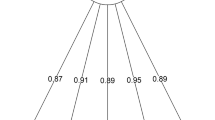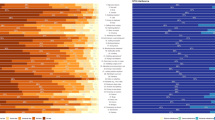Abstract
Despite an abundance of self-report measures that screen for the presence of specific phobias, there is a lack of comprehensive, well-validated screening tools for identifying a wide range of fears based on DSM-5 specific phobia types. The current paper reports on the psychometric properties and clinical utility of the Specific Phobia Questionnaire (SPQ), a new screening tool for assessing fear of a broad range of phobic stimuli, and the extent to which fear interferes with daily life. An exploratory factor analysis revealed five factors with internal consistency (Cronbach’s α) ranging from .64–.92. The SPQ also demonstrated good convergent and discriminant validity with measures of worry, depression, and other specific phobias, and good test-retest reliability. Results also suggest that SPQ scores are useful for discriminating individuals with specific phobias from those without specific phobias, and for identifying specific phobia types. Overall, preliminary results suggest that the SPQ can serve as a useful tool in both research and clinical settings, and inform intervention and prevention efforts.
Similar content being viewed by others
Notes
Data were collected prior to the release of the DSM-5. Changes in diagnostic criteria for anxiety disorders from DSM-IV to DSM-5 likely do not impact the findings of the current study.
ROC Analyses were also conducted for the interference subscale; AUC for the interference subscale was also significant in predicting specific phobias (AUC = .69, 67% sensitivity/60% specificity)
ROC Analyses were also conducted for the interference subscales; AUCs for the interference subscales (AUC = .72–.83, all ps < .001) were significantly better than chance for discriminating individuals with DSM-5 specific phobias.
References
American Psychiatric Association. (2013). Diagnostic and statistical manual for mental disorders (5th ed.). Arlington, VA: American Psychiatric Publishing.
Antony, M. M., Brown, T. A., & Barlow, D. H. (1997). Heterogeneity among specific phobia types in DSM-IV. Behaviour Research and Therapy, 35, 1089–1100.
Antony, M. M., Bieling, P. J., Cox, B. J., Enns, M. W., & Swinson, R. P. (1998). Psychometric properties of the 42-item and 21-item versions of the Depression Anxiety Stress Scales in clinical groups and a community sample. Psychological Assessment, 10, 176–181.
Fairbrother, N. & Antony, M. M. (2012). Specific Phobia Questionnaire. Unpublished scale.
Baker, B. L., Cohen, D. C., & Saunders, J. T. (1973). Self-directed desensitization for acrophobia. Behaviour Research and Therapy, 11, 79–89.
Barlow, D. H. (2002). Anxiety and its disorders: the nature and treatment of anxiety and panic. New York: Guilford Press.
Beck, J. G., Carmin, C. N., & Henninger, N. J. (1998). The utility of the fear survey schedule-III: an extended replication. Journal of Anxiety Disorders, 12, 177–182.
Bernstein, D. A., & Allen, G. J. (1969). Fear survey schedule (II): Normative data and factor analyses based upon a large college sample. Behaviour Research and Therapy, 7, 403–407.
Bornas, X., & Tortella-Feliu, M. (1995). Descripcion y analisis psicometrico de un instrument de autoinforme para la evaluacion del miedo aVolar [Description and psychometric properties of a self- report assessment measure for fear of flying]. Psicología Conductual, 3, 67–86.
Brown, T. A., & Barlow, D. H. (2014). Anxiety and related disorders interview schedule for DSM-5: Client interview schedule. New York: Oxford University Press.
Bryant, F. B., Yarnold, P. R., & Michelson, E. A. (1999). Statistical methodology: VIII. Using confirmatory factor analysis (CFA) in emergency medicine research. Academic Emergency Medicine: Official Journal of the Society for Academic Emergency Medicine, 6, 54–66.
Cohen, D. C. (1977). Comparison of self-report and overt-behavioral procedures for assessing acrophobia. Behavior Therapy, 8, 17–23.
Cutshall, C., & Watson, D. (2004). The phobic stimuli response scales: a new self-report measure of fear. Behaviour Research and Therapy, 42, 1193–1201.
Davey, G. C. L. (1992). Characteristics of individuals with fear of spiders. Anxiety Research, 4, 299–314.
Field, A. P. (2013). Discovering statistics using IBM SPSS statistics: And sex and drugs and rock ‘n’ roll (4th ed.). London, UK: Sage Publications.
First, M. B., Spitzer, R. L., Gibbon, M., & Williams, J. B. W. (1995). Structured clinical interview for DSM-IV Axis I disorders. New York: Biometrics Research Department, New York State Psychiatric Institute.
First, M. B., Williams, J. B. W., Karg, R. S., & Spitzer, R. L. (2015). Structured clinical interview for DSM-5—research version. Arlington, VA: American Psychiatric Publishing.
Fredrikson, M., Annas, P., Fischer, H., & Wik, G. (1996). Gender and ages differences in the prevalence of specific fears and phobias. Behaviour Research and Therapy, 3, 33–39.
Geer, J. H. (1965). The development of a scale to measure fear. Behaviour Research and Therapy, 3, 45–53.
Gerdes, A. B. M., Uhl, G., & Alpers, G. W. (2009). Spiders are special: fear and disgust evoked by pictures of arthropods. Evolution and Human Behavior, 30, 66–73.
Henson, R., & Roberts, J. (2006). Use of exploratory factor analysis in published research: Common errors and some comment on improved practice. Educational and Psychological Measurement, 66, 393–416.
Hayton, J. C., Allen, D. G., & Scarpello, V. (2004). Factor retention decisions in exploratory factor analysis: A tutorial on parallel analysis. Organizational Research Methods, 7, 191–205.
Havlicek, L. L., & Peterson, N. L. (1977). Effect of the violation of assumptions upon significance levels of the Pearson r. Psychological Bulletin, 84, 373–377.
Henry, J. D., & Crawford, J. R. (2005). The short-form version of the Depression Anxiety Stress Scales (DASS-21): Construct validity and normative data in a large non-clinical sample. British Journal of Clinical Psychology, 44, 227–239.
Hood, H. K., & Antony, M. M. (2012). Evidence-based assessment and treatment of specific phobias in adults. In T. E. Davis III, T. H. Ollendick, & L.-G. Öst (Eds.), Intensive one-session treatment of specific phobias (pp. 19–41). New York: Springer.
Hu, L., & Bentler, P. M. (1999). Cutoff criteria for fit indexes in covariance structure analysis: Conventional criteria versus new alternatives. Structural Equation Modeling, 6, 1–55.
Jöreskog, K. G., & Sörbom, D. (2012). LISREL 9.10 for Windows [Computer software]. Skokie, IL: Scientific Software International, Inc..
Kessler, R. C., Berglund, P., Demler, O., Jin, R., Merikangas, K. R., & Walters, E. E. (2005a). Lifetime prevalence and age-of-onset distributions of DSM-IV disorders in the national comorbidity survey replication. Archives of General Psychiatry, 62, 593–602.
Kessler, R. C., Chiu, W. T., Demler, O., & Walters, E. E. (2005b). Prevalence, severity, and comorbidity of 12-month DSM-IV disorders in the national comorbidity survey replication. Archives of General Psychiatry, 62, 617–627.
Klieger, D. M., & Franklin, M. E. (1993). Validity of the fear survey schedule in phobia research: a laboratory test. Journal of Psychopathology and Behavioral Assessment, 15, 207–217.
Kline, R. B. (2005). Principles and practice of structural equation modeling (2nd ed.). New York, NY: Guilford.
LeBeau, R. T., Glenn, D., Liao, B., Wittchen, H., Beesdo-Baum, K., Ollendick, T., & Craske, M. G. (2010). Specific phobia: a review of DSM-IV specific phobia and preliminary recommendations for DSM-V. Depression and Anxiety, 27, 148–167.
Lovibond, P. F., & Lovibond, S. H. (1995). The structure of negative emotional states: comparison of the Depression Anxiety Stress Scales (DASS) with the Beck Depression and Anxiety Inventories. Behaviour Research and Therapy, 33, 335–342.
Metzger, R. L., Miller, M. L., Cohen, M., & Sofka, M. (1990). Worry changes decision making: The effect of negative thoughts on cognitive processing. Journal of Clinical Psychology, 46, 78–88.
Meyer, T. J., Miller, M. L., Metzger, R. L., & Borkovec, T. D. (1990). Development and validation of the Penn State Worry Questionnaire. Behaviour Research and Therapy, 28, 487–495.
Molina, S., & Borkovec, T. D. (1994). The Penn State Worry Questionnaire: Psychometric properties and associated characteristics. In G. C. L. Davey & F. Tallis (Eds.), Worrying: Perspectives on theory, assessment and treatment (pp. 265–283). Oxford, UK: John Wiley and Sons.
Muris, P., Schmidt, H., & Merckelbach, H. (1999). The structure of specific phobia symptoms among children and adolescents. Behaviour Research and Therapy, 37, 863–868.
Muris, P., Mayer, B., Huijding, J., & Konings, T. (2008). A dirty animal is a scary animal! Effects of disgust-related information on fear beliefs in children. Behaviour Research and Therapy, 46, 137–144.
Osborne, J. W., & Costello, A. B. (2004). Sample size and subject to item ratio in principal factors analysis. Practical Assessment, Research and Evaluation, 9, 1–9.
Page, A. C., Bennett, K. S., Carter, O., Smith, J., & Woodmore, K. (1997). The blood-injection symptom scale (BISS): assessing a structure of phobic symptoms elicited by blood and injections. Behaviour Research and Therapy, 35, 457–464.
Radomsky, A. S., Rachman, S., Thordarson, D. S., McIsaac, H. K., & Teachman, B. A. (2001). The Claustrophobia questionnaire. Journal of Anxiety Disorders, 15, 287–297.
Stinson, F. S., Dawson, D. A., Chou, P. S., Smith, S., Goldstein, R. B., Ruan, J., & Grant, B. F. (2007). The epidemiology of DSM-IV specific phobia in the USA: results from the national epidemiologic survey on alcohol and related conditions. Psychological Medicine, 37, 1047–1059.
Szymanski, J., & O’Donohue, W. (1995). Fear of Spiders Questionnaire. Journal of Behavior Therapy and Experimental Psychiatry, 26, 31–34.
Trumpf, J., Margraf, J., Vriends, N., Meyer, A. H., & Becker, E. S. (2010). Specific phobia predicts psychopathology in young women. Social Psychiatry and Psychiatric Epidemiology, 45, 1161–1166.
Weiss, B. W., Katkin, E. S., & Rubin, B. M. (1968). Relationship between a factor analytically derived measure of a specific fear and performance after related fear induction. Journal of Abnormal Psychology, 73, 461–463.
Wolitzky-Taylor, K. B., Horowitz, J. D., Powers, M. B., & Telch, M. J. (2008). Psychological approaches in the treatment of specific phobias: a meta-analysis. Clinical Psychology Review, 28, 1021–1037.
Wolpe, J., & Lang, P. (1977). Manual for the fear survey schedule. San Diego: EdITS.
Author information
Authors and Affiliations
Corresponding author
Ethics declarations
Conflict of Interest
Melina Ovanessian, Nichole Fairbrother, Valerie Vorstenbosch, Randi McCabe, Karen Rowa and Martin Antony declare that they have no conflict of interest.
Ethical Approval
All procedures performed in studies involving human participants were in accordance with the ethical standards of the institutional and/or national research committee and with the 1964 Helsinki declaration and its later amendments or comparable ethical standards.
Informed Consent
Informed consent was obtained from all individual participants included in the study.
Appendices
Appendix A
SPECIFIC PHOBIA QUESTIONNAIRE (SPQ)



Appendix B
Specific Phobia Questionnaire Scoring Instructions
The Specific Phobia Questionnaire (SPQ; Fairbrother and Antony 2012) was designed to assess the extent of fear and interference for a broad range of objects and situations. The SPQ consists of 43 items, each rated using a 5-point Likert scale on two dimensions: (1) level of fear, with scores ranging from 0 (no fear) to 4 (extreme fear) and (2) extent to which the fear interferes with one’s daily life, with scores ranging from 0 (no interference) to 4 (extreme interference).
The SPQ is scored by combining fear ratings of each DSM-5 specific phobia type to create five different composite scores:
-
Animals (sum of items 3, 6, 8, 11, 30, 31, 36, 37, 39, 43)
-
Natural Environment (sum of items 1, 2, 13, 14, 23, 27, 32, 33, 38)
-
Situational (sum of items 4, 7, 16, 22, 26, 29, 34, 40)
-
Blood-Injection-Injury (sum of items 5, 9, 10, 15, 17, 18, 19, 21, 24, 25, 28, 35, 41, 42)
-
Other (sum of items 12, 20)
Rights and permissions
About this article
Cite this article
Ovanessian, M.M., Fairbrother, N., Vorstenbosch, V. et al. Psychometric Properties and Clinical Utility of the Specific Phobia Questionnaire in an Anxiety Disorders Sample. J Psychopathol Behav Assess 41, 36–52 (2019). https://doi.org/10.1007/s10862-018-9687-1
Published:
Issue Date:
DOI: https://doi.org/10.1007/s10862-018-9687-1




